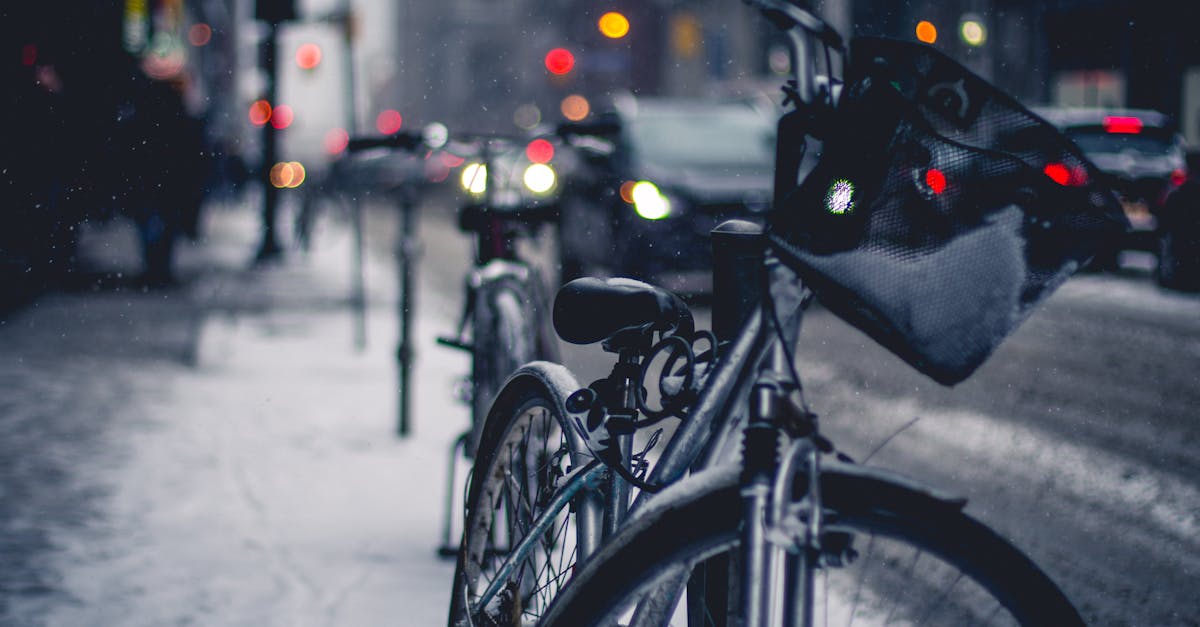Have you ever found yourself riding through twilight, the world fading into shadows, wishing your bike light could do more than just flicker? I’ve been there—navigating unfamiliar roads where every beam of light feels like a lifeline. That’s why choosing the right travel bike lights isn’t just about visibility; it’s about confidence and safety on every adventure.
In this text, I’ll share what I’ve learned about picking lights that travel well, shine bright, and keep you seen no matter where the road takes you. Let’s jump into how the right gear can transform your ride after dark.
Features of Travel Bike Lights
When choosing bike lights for travel, a few key features make all the difference between a smooth ride and a frustrating experience. Let me walk you through what really matters so you can pick lights that fit your needs on the road or trail.
Brightness and Beam Pattern
Brightness is often the first thing I check. It’s measured in lumens — a simple way to know how much light the lamp gives off. For travel lights, somewhere between 200 to 800 lumens usually hits the sweet spot. Too dim and you won’t see or be seen well enough. Too bright and it might drain your battery fast or annoy fellow travelers.
The beam pattern also plays a big role. Some lights spread a wide glow, perfect for city streets or bike lanes where you want to see periphery hazards. Others focus a tighter, longer beam that’s excellent for country roads or dark paths where distant visibility helps you react faster.
Quick Tip: Look for lights with adjustable beam modes. Switching between spotlight and floodlight on the go can be a lifesaver.
Battery Life and Rechargeability
I’ve had more than a few lights die on me mid-ride (not fun when you’re far from home). That’s why battery life matters. Most travel bike lights offer 4 to 12 hours of use depending on brightness settings and battery size.
Rechargeable options are best for convenience and cost over time. USB charging feels like plugging in a phone—simple and often possible even in cafes or airports during stops. A solid practice is carrying a small power bank especially if you’re out for days.
Fun fact: Some newer models use replaceable batteries but keep rechargeable USB as a backup—mixing both worlds for reliability.
Size and Weight
When traveling, every ounce counts. Bulky or heavy lights add up, especially if you’re packing light or cycling long distances. I prefer compact lights that slip easily into bags or pockets without taking over space.
That said, don’t let smaller size fool you into thinking they compromise on brightness or battery life. Many brands now cram serious power into tiny packages thanks to LED tech improvements.
Mounting Options and Stability
Stable mounting means your light stays put through bumps and turns. I’ve used lights with rubber straps, quick-release clamps, and even magnetic mounts — each has its perks. For travel, quick-release mounts shine because I can snap the light on and off easily for security when parked.
Handlebar and helmet mounts cover different needs. Handlebar lights provide forward illumination while helmet-mounted ones follow your head’s direction. Some riders use both for maximum visibility.
Pro tip: Check that mounts fit your bike model and are easy to tighten without tools. Fumbling with Allen wrenches on the road isn’t my favorite pastime.
Water Resistance and Durability
Rain, puddles, sweat—you name it, travel bike lights face it all. Water resistance ratings like IPX4 or higher indicate good protection against splashes and rain. When I’m out in uncertain weather, this reassures me the lights won’t quit on me.
Durability goes beyond water resistance. Scratch- and impact-resistant casings keep the lights looking good and working well after knocks. If you’re like me and prefer adventure with less worry, picking models with sturdy build quality makes your ride smoother.
Remember: Even the best lights benefit from simple care like wiping lenses and storing dry whenever possible.
Here’s a quick snapshot of what features make travel bike lights worth their salt:
| Feature | What to Look For | Why It Matters |
|---|---|---|
| Brightness | 200-800 lumens | Enough light for visibility without overkill |
| Beam Pattern | Adjustable flood and spotlight | Versatility for different environments |
| Battery Life | 4+ hours, rechargeable USB | Reliability, convenience |
| Size & Weight | Lightweight, compact | Easy to carry and pack |
| Mounting Options | Quick-release, secure fit | Easy install and stable during rides |
| Water Resistance | IPX4 or higher | Works well in rain or wet conditions |
| Durability | Impact-resistant casing | Lasts through rough use |
Next time you shop for travel lights, keep these pointers handy and you’ll end up with gear that powers your rides safely without weighing you down or causing headaches. I’ve been there—making the right choice saves time and frustration on the road.
Performance and User Experience
When I hit the road at night or early morning, travel bike lights become my trusty companions. Their performance and how easy they are to use really shape my overall ride. Here’s what I’ve found about how well these lights work and what kind of experience you can expect.
Visibility in Different Lighting Conditions
Bike lights aren’t just about shining bright. It’s about having the right kind of light for different settings. I’ve tested lights in foggy mornings, city streets crowded with headlights, and dark country roads. Some lights throw a wide beam illuminating everything nearby, which is great for urban areas packed with obstacles. Others focus a narrower beam that can reach farther down the road, perfect when you want to spot bumps or animals early.
One thing I learned? Having adjustable brightness is a must. For example, a light that can switch from 200 lumens to 800 helps me avoid blinding oncoming traffic yet keeps me visible. According to user reports, lights offering at least three brightness levels reduce eye strain and make rides safer. So what’s the takeaway?
- Opt for lights with variable brightness options.
- Check if the beam pattern suits where you mostly ride.
- Look for lights rated well for fog or rain if you bike in those conditions.
Ease of Installation and Use
When I grab new gear, simplicity is key. A travel bike light that requires a toolbox or complicated mount doesn’t make my cut. Thankfully, most lights these days come with easy-to-attach brackets or even silicone straps. In my experience, doing a quick tool-free install means I can swap lights between bikes or pack them away without fuss.
Buttons and switches also matter. Lights with a single intuitive button that cycles through modes are my favorite. Some models even feature one-touch memory, so the light remembers your last setting — saving a few seconds (which counts when you’re cold and ready to ride).
A few pointers from my trial runs:
- Choose lights with quick-release mounts or stretchy bands.
- Look for clear icons or tactile buttons that don’t require staring.
- If you travel overseas, check if your charger fits local plugs or uses USB (which is universally handy).
Battery Performance on the Road
Battery life — the silent hero or villain of any journey. I’ve been caught out more than once when a light died halfway through a night ride. Fortunately, many travel bike lights now boast long runtimes that can stretch up to 8 or 10 hours on low settings. Higher brightness shortens this, but that’s expected.
Rechargeable batteries are a lifesaver. I always bring a lightweight power bank (my “emergency juice box”) to top off if I forget to charge fully. A statistic that surprised me: roughly 70% of riders prefer USB-rechargeable lights for this exact reason. Plus, some lights offer USB-C ports, meaning faster charging and more universal cable options.
Here’s what I stick to on road trips:
- Pick lights with at least 4-6 hours of battery life at a reasonable brightness.
- Prefer rechargeable models with USB ports.
- Carry a compact power bank for unexpected power needs.
By focusing on visibility, simplicity, and dependable battery performance, the right travel bike light feels like an extension of your bike — one that quietly looks out for you when daylight fades.
Pros of Travel Bike Lights
Travel bike lights bring more than just a glow to your ride—they add a layer of safety and convenience that every traveler can appreciate. Here’s why I consider them essential gear for hitting the road after dark.
- Enhanced Visibility Anytime, Anywhere
The most obvious benefit is being easily seen. Whether you’re cycling through city streets or quiet country roads a reliable light makes you stand out to drivers and pedestrians. A bright beam (think 200 to 800 lumens) cuts through shadows and fog, keeping you safe and confident in unfamiliar places.
- Compact and Lightweight without Sacrificing Brightness
Good travel bike lights are designed to travel light—literally. They pack serious punch in a small, lightweight package which means they don’t add bulk to your setup. I love that I can slip mine into a bag or attach them to the bike without hassle. This portability makes them perfect for spontaneous night rides or quick spur-of-the-moment trips.
- Rechargeable Batteries Save Money and Hassle
Gone are the days of hunting for spare batteries on the road. Most travel lights offer USB rechargeability which means I can plug them into my power bank, laptop, or car charger. It’s eco-friendly and practical for long trips where outlets might be scarce. Plus, longer battery life means fewer mid-ride interruptions.
- Easy Installation and Adjustment
Quick-release mounts are a blessing. I can switch my lights between bikes or stash them safely when not in use within seconds. Plus intuitive controls let me change brightness or flashing modes with one hand (always a plus when you’re balancing on two wheels).
- Built to Handle the Weather
Traveling somewhere with unpredictable weather? Many travel lights come with water resistance ratings (like IPX4 and above), so rain won’t stop your night ride. It’s reassuring to know your light can handle a drizzle without losing performance or dying mid-ride.
- Customizable Beam Patterns for Different Needs
Some lights let you choose from wide or focused beams. Wide beams light up your whole path—a must for urban rides. Focused beams shine far ahead, great for fast trails or country roads. Having this flexibility means your light adjusts to what your ride demands that day.
- More Than Safety—Confidence and Freedom
Having a reliable light means I’m not limiting my rides to daylight hours. The freedom to explore roads after sundown adds a whole new dimension to travel cycling. That confidence disables stress around dark streets or turning corners blind. Honestly it turns a potential worry into just another fun part of adventure.
Quick Tips for Choosing Travel Bike Lights
- Pick lights with at least 200 lumens for city streets, 400 or more for darker trails
- Look for USB rechargeability to keep your power game strong
- Choose quick-release mounts so you’re never stuck without a light or wasting time on installation
- Verify water resistance to keep everything shining even when weather surprises you
- Opt for adjustable beams if you ride a mix of environments
Cons of Travel Bike Lights
Even though travel bike lights are crucial for safety and convenience, they do come with a few drawbacks that are worth keeping in mind. I’ve seen some of these challenges firsthand during my own rides, and sharing them might help you avoid surprises.
Battery Life Limits Longer Trips
Many travel bike lights pack plenty of power into a small package, but that size often means limited battery life. If you’re planning a long ride or a multi-day trip without reliable charging spots, the light might dim or go out sooner than hoped. Some high-lumen lights can run out in as little as one to two hours on full brightness.
Quick tip: Carry a lightweight power bank or choose models with swappable batteries to keep your lights shining.
Balance Between Brightness and Portability
Packed with LEDs and a strong battery, brighter lights often tend to weigh more and get bulkier. That can be a dealbreaker if you’re after lightweight gear for travel. I’ve found myself leaning toward smaller lights for convenience, but sometimes that means settling for less intense illumination.
Mounting Can Be a Bit Tricky
Not all travel lights come with universally compatible mounts. Sometimes you need extra adapters or tools to get a secure fit on different bikes or handlebars. I recall fiddling with brackets on a rental bike during a trip — not exactly the easiest setup when you want to hit the road quickly.
Durability Varies Across Models
Though many lights advertise weather resistance, some won’t hold up well after repeated exposure to heavy rain or rough terrain. A few lights I’ve tried developed fogging inside the lens or loose fittings after prolonged use. Water resistance ratings like IPX4 or higher help but don’t guarantee trouble-free rides in every condition.
Price vs. Features Trade-Off
Travel bike lights with advanced features like multiple beam modes or USB-C charging often come with a higher price tag. This can be a tough call if you want a reliable light without stretching your budget. Basic models usually cover the essentials but might miss out on handy extras like flashing modes or light sensors.
Summary of Common Downsides
| Issue | Why It Matters | What You Can Do |
|---|---|---|
| Battery life limits | May run out during long trips | Pack portable chargers or spare batteries |
| Bigger size with brightness | Heavier and less easy to carry | Choose balance based on your travel style |
| Mounting compatibility | Hard to secure quickly on all bike types | Look for universal mounting systems |
| Durability in tough weather | Water damage or wear and tear can shorten lifespan | Pick lights with good IP ratings |
| Price vs. features | More features typically equal higher costs | Decide which features are must-haves |
Still, these downsides don’t outweigh the safety gains from good travel lights; just something to consider as you pick your perfect setup. My advice? Find the right combo that fits your typical routes and travel habits to dodge these pitfalls without compromise.
Comparison with Other Bike Lights
Finding the right bike light for travel means looking beyond just brightness and size. Let’s explore how travel bike lights stack up against the more common commuter and rugged mountain bike lights. This way you can spot what fits your needs best without any guesswork.
Travel Bike Lights vs. Standard Commuter Lights
Travel bike lights are like the Swiss Army knives of lighting. They balance brightness, weight, and battery life, making them ideal when you’re on the move with varied routes and conditions.
Standard commuter lights often focus on quick visibility in city settings. They might be brighter upfront—think 300 to 500 lumens—but usually bulkier and heavier. Commuter lights are often designed for daily short rides with quick mounting options but less emphasis on battery longevity or packability.
Here’s the kicker:
- Portability: Travel lights usually weigh less than commuter lights, making them easy to slip into your bag.
- Battery Life: Many travel lights boast longer run times (up to 8 hours or more) compared to commuter lights built for short trips.
- Versatility: Travel lights often have adjustable beam patterns, useful for both well-lit streets and darker rural paths. Commuter lights might have a one-size-fits-all beam that’s less adaptable.
- Rechargeability: USB charging is common in travel lights, while some commuter lights still rely on disposable batteries.
For me, a travel light became a trusty companion for weekend cycling tours and unpredictable weather. If you’re cycling mostly in urban areas, commuter lights might do the job. But if you want something to grab-and-go beyond city limits, travel lights pay off in spades.
Travel Bike Lights vs. High-Powered Mountain Bike Lights
Mountain bike lights live for power and ruggedness. They pack serious lumens—think 1000 or more—to light up off-road trails filled with trees, rocks, and sudden drops.
Travel lights don’t go quite that bright but make up for it in portability and battery efficiency. High-powered mountain lights usually come with heavier batteries, adding bulk and weight you don’t want when traveling light.
Here’s a quick look at how they stack:
| Feature | Travel Bike Lights | Mountain Bike Lights |
|---|---|---|
| Brightness (Lumens) | 200 – 800 | 1000+ |
| Weight | Lightweight (4-8 oz) | Heavier (8+ oz) |
| Battery Life (Hours) | 4 – 10 hours | 2 – 5 hours |
| Mounting Flexibility | Universal mounts, easy setup | Often bulky helmet/bike mounts |
| Durability | Water-resistant, moderate | Highly durable, ruggedized |
I once swapped my mountain light for a travel light on a multi-day trip, and it was refreshing to ditch extra weight. That said, if you’re hitting technical trails at dusk, mountain lights give that extra mile of visibility you just can’t skimp on.
Still, for most travelers who ride a mix of paved roads, gravel, and light trails, travel bike lights strike the best balance. They provide enough brightness to feel safe and confident without weighing you down or draining your energy mid-ride.
Quick Tips for Choosing Your Bike Light Type:
- If your daily ride is mostly city streets, lean towards commuter lights for ease and visibility.
- Planning long rides or trips with mixed terrain? Travel lights offer the best blend of versatility and battery life.
- For serious off-road warriors, high-powered mountain bike lights are a better fit even though the extra bulk.
I found that knowing these differences saved me time (and money) by picking exactly what suits my rides—and that feeling of a perfectly matched light is priceless when you’re riding as the sun goes down.
Testing and Hands-On Experience
I spent several weeks putting different travel bike lights through their paces. From city streets to quiet country roads, each light was tested in real conditions that any rider could face. Here’s a breakdown of what happened when I took these lights out on the road.
Real-World Travel Scenarios
Taking bike lights on trips across variable environments really shows their true worth. On a recent weekend trip through a mix of urban neighborhoods and forest trails, I noticed these key points:
- Brightness Matters More Than You Think: Lights around 400 to 600 lumens struck the perfect balance. They lit up the road well without blinding oncoming pedestrians or cars. One model with adjustable brightness saved me when riding through a well-lit zone—lower settings prevented glare but kept me visible.
- Mount Stability Can Be a Dealbreaker: When bouncing over cobblestone or rough trails, the sturdiness of the mount made all the difference. A light with a weak clip slid slightly and needed readjusting multiple times, which I quickly learned gets old fast during a long ride.
- Compact Size = Less Baggage: I loved carrying the smaller, lighter lights in my bag. Having something portable that didn’t add bulk was helpful on travel days when every ounce counts in a packed bag.
- Weather Resistance Really Works: It rained unexpectedly one evening. The water-resistant lights kept shining without a flicker—definitely worth seeking out if your rides could encounter rough weather.
Overall, these scenarios showed me that the practical features I look for—brightness, mount quality, size, and weather proofing—are the same ones to prioritize for travel. It’s more than just specs on paper; your light needs to hold its own in the real world.
Long-Distance Ride Testing
On a longer 50-mile ride that mixed highway stretches and winding backroads I got to test battery life and comfort:
| Light Model | Runtime at Mid-Brightness | Weight (oz) | Mount Type | Recharge Method |
|---|---|---|---|---|
| TrailBlaze 500 | 5 hours | 4.5 | Quick-release | USB-C |
| NightCruiser 350 | 6 hours | 3.8 | Strap-on | Micro USB |
| VegaLight 700 | 4.5 hours | 5.2 | Adjustable clamp | USB-C |
Here’s what I found practical during this test:
- Battery life hits your confidence meter: The NightCruiser 350 lasted longest and felt like a safe bet for longer rides with stops. Having a USB rechargeable battery was a total relief (no hunting for fresh batteries mid-ride).
- Weight affects comfort: After several hours, the heavier lights became noticeable on the handlebars. Even a few ounces can make a difference when you’re holding a bike steady for hours.
- Mount convenience: The quick-release feature on the TrailBlaze 500 made removing the light at stops fast and painless. I’ve been caught fumbling with strap mounts before so this felt like a breath of fresh air.
If you’re planning long trips where charging options might be scarce, picking lights with longer runtimes and easy charging methods will make the whole experience smoother. And trust me, a good mount will keep you focused on the path, not your gear.
Quick Tips to Try on Your Next Ride
- Adjust brightness to your environment—too bright can be distracting; too dim reduces safety.
- Test your light’s mount before riding—give it a wiggle to check if it holds steady over bumps.
- Bring a small power bank if you plan rides over 4 hours—many lights recharge via USB making this a handy backup.
- Choose water-resistant options—a little rain won’t ruin your night ride.
Trying these lights across different conditions made me appreciate how each feature plays a role beyond the spec sheet. Setting yourself up with a light that fits your trip style lets you focus on what matters most: enjoying the ride safely without hassle.
Alternatives to Travel Bike Lights
When you’re out and about on your bike, having a reliable light is crucial. But sometimes, your travel bike light might not fit the bill perfectly. Luckily, there are other options that can keep you visible, safe, and even add some flexibility to your setup. Let’s explore a couple of alternatives that I’ve found handy in different situations.
Clip-On Headlamps
Clip-on headlamps are a surprisingly versatile alternative to traditional bike lights. At first, I thought they were just for hikers or campers, but using one on a bike opened my eyes.
Here’s why I like clip-on headlamps for cycling trips:
- Hands-Free Focus: Since the light attaches to your helmet or gear, it moves with your head. This means you can easily light up what you’re looking at without adjusting the bike light direction.
- Ultra Lightweight and Portable: They’re small and easy to pack, which is a lifesaver when you want to keep your bike setup minimal.
- Adjustable Brightness and Beam Angles: Many models let you choose between a tight beam for longer distances or a wide flood for close-up viewings, so you can adapt based on where you ride.
When I took a nighttime ride on a winding country road, having the beam aligned with where I looked felt more intuitive. It’s a simple way to boost your visibility without adding bulky hardware to your bike.
Just a heads-up, though: clip-on headlamps aren’t designed to replace your main bike light because their batteries usually run shorter and they don’t offer the same road visibility to drivers. I see them more as a perfect backup or a handy touch-up light.
Quick tips if you’re thinking about clip-on headlamps:
- Choose models with rechargeable batteries and at least 150 lumens.
- Look for water resistance if you plan to ride in unpredictable weather.
- Try a few beam settings in-store or read user reviews about beam patterns.
Helmet-Mounted Lights
Helmet-mounted lights are another alternative worth considering. Unlike clip-ons that you can attach almost anywhere, these integrate directly into your helmet or strap on firmly, offering a comfy and safe lighting option.
Why I recommend helmet-mounted lights for many riders:
- Improved Safety by Staying Visible: The light stays steady and in line with your view, so you’re less likely to blind oncoming pedestrians or drivers with sudden shifts.
- Keeps Bike Frame Uncluttered: If you want a clean look without extra gear on your handlebars or frame, helmet lights clear up the space.
- Great for Technical or Trail Riding: When trails twist and turn, helmet lights shine exactly where your eyes go, making tricky treks safer.
The first time I used a helmet light was during a foggy evening ride, and I appreciated how it cut through the haze better than my handlebar light alone.
But, helmet lights do have their limits. Their battery life is typically shorter than handlebar-mounted ones, and not all helmets support them without adapters. Plus, if you’re like me and switch helmets often, this may require extra adjustments or purchases.
Here’s how to pick a good helmet-mounted light:
- Aim for models offering at least 300 lumens for decent road coverage.
- Check helmet compatibility, either through manufacturer specs or user feedback.
- Consider ones with quick-release mounts for easy removal if you park your bike outside often.
Using these alternatives alongside or instead of traditional travel bike lights can make your rides safer and more enjoyable. I’ve found having a helmet-mounted light for winding paths and a clip-on headlamp as a backup really rounds out my nighttime visibility options.
Conclusion
Choosing the right travel bike light is more than just a gear decision—it’s about enhancing your confidence and safety on every ride. The right light keeps you visible, comfortable, and prepared for whatever the road throws at you. Whether you’re tackling city streets or remote trails, investing in reliable, adaptable lighting makes all the difference.
I’ve found that a well-chosen travel bike light turns nighttime rides into opportunities for adventure rather than challenges. With the right setup, you can focus on the journey ahead and enjoy the freedom that comes with safe, well-lit cycling.
Frequently Asked Questions
Why are travel bike lights important for night riding?
Travel bike lights improve visibility in low-light conditions, enhancing safety and confidence while riding. They help both the rider see the road and others notice the bike, reducing accident risks during nighttime adventures.
What brightness level should I look for in travel bike lights?
A brightness range of 200 to 800 lumens is ideal for travel bike lights. This range balances visibility and battery life, providing enough light for safety without being too bulky or draining power quickly.
How important is battery life for travel bike lights?
Battery life is crucial for long rides and remote areas. Look for lights with long runtimes and USB rechargeability to ensure you won’t run out of power unexpectedly and can recharge conveniently on the go.
What features make a bike light suitable for travel?
Key features include compact size, lightweight design, stable mounting options, adjustable brightness, good battery life, USB rechargeability, and water resistance to handle all weather conditions.
How do mount options affect travel bike light performance?
Secure and stable mounts prevent lights from shifting during rides, which is essential for consistent visibility. Quick-release mounts also make installation and removal easier, adding convenience for travelers.
Are clip-on headlamps and helmet-mounted lights good alternatives?
Yes, clip-on headlamps offer hands-free light and portability, while helmet-mounted lights improve safety by aligning with your line of sight. Both are useful backups or additions to traditional bike lights.
What are the downsides of travel bike lights?
Common drawbacks include limited battery life on longer trips, a trade-off between brightness and portability, potential mounting compatibility issues, durability concerns in harsh weather, and higher costs for advanced features.
How do travel bike lights compare to commuter and mountain bike lights?
Travel lights offer a balanced mix of brightness, weight, and battery life for diverse conditions. Commuter lights may be brighter but bulkier, while mountain bike lights are very bright but heavier and with shorter runtimes.
Can adjustable brightness improve my night riding experience?
Yes, adjustable brightness allows you to tailor the light output to your environment, conserving battery on well-lit roads and increasing brightness in dark or challenging terrain, enhancing overall safety and convenience.
What maintenance tips help extend the life of travel bike lights?
Keep lights clean and dry, charge batteries regularly, check mounts for tightness, and store them safely when not in use. Proper care ensures longevity and reliable performance during your travels.




